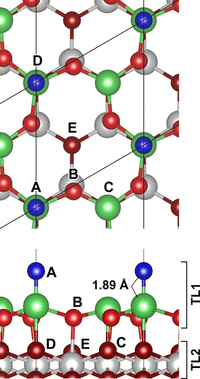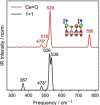Ce=O Terminated CeO2
- PMID: 33826220
- PMCID: PMC8251574
- DOI: 10.1002/anie.202101771
Ce=O Terminated CeO2
Abstract
Multiply bonded lanthanide oxo groups are rare in coordination compounds and have not previously been reported for a surface termination of a lanthanide oxide. Here we report the observation of a Ce=O terminated ceria surface in a CeO2 (111)-( × )R30° reconstruction of ≈3 nm thick ceria islands prepared on Pt(111). This is evidenced by scanning tunnelling microscopy (STM), low energy electron diffraction (LEED) and high-resolution electron energy loss spectroscopy (HREELS) measurements in conjunction with density functional theory (DFT) calculations. A Ce=O stretching frequency of 775 cm-1 is observed in HREELS, compared with 766 cm-1 calculated by DFT. The calculations also predict that the Ce=O bond is weak, with an oxygen vacancy formation energy of 0.85 eV. This could play an important role in the facile removal of lattice oxygen from CeO2 , accompanied by the reduction of CeIV to CeIII , which is a key attribute of ceria-based systems in connection with their unique catalytic properties.
Keywords: cerium dioxide; density functional calculations; heterogeneous catalysis; multiple bonds; scanning tunnelling microscopy.
© 2021 The Authors. Angewandte Chemie International Edition published by Wiley-VCH GmbH.
Conflict of interest statement
The authors declare no conflict of interest.
Figures





References
-
- Rodriguez J. A., Grinter D. C., Liu Z., Palomino R. M., Senanayake S. D., Chem. Soc. Rev. 2018, 46, 1724–1841. - PubMed
-
- Liu Z., Huang E., Orozco I., Liao W., Palomino R. M., Rui N., Duchon T., Nemšák S., Grinter D. C., Mahapatra M., Liu P., Rodriguez J. A., Senanayake S. D., Science 2020, 368, 513–517. - PubMed
-
- Montini T., Melchionna M., Monai M., Fornasiero P., Chem. Rev. 2016, 116, 5987–6014. - PubMed
-
- Mao Z., Lustemberg P., Rumptz J. R., Ganduglia-Pirovano M. V., Campbell C. T., ACS Catal. 2020, 10, 5101–5114.
-
- Esch F., Fabris S., Zhou L., Montini T., Africh C., Fornasiero P., Comelli G., Rosei R., Science 2005, 309, 752–755. - PubMed
Grants and funding
LinkOut - more resources
Full Text Sources
Other Literature Sources

